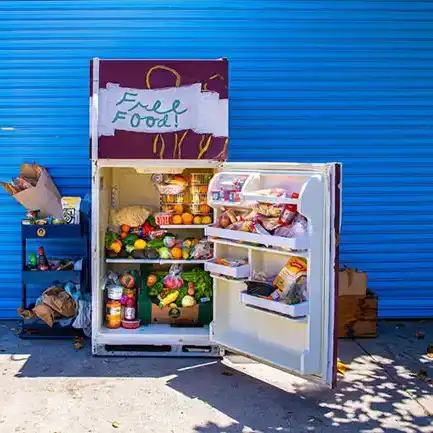Lack of food literacy has contributed to startling rates of obesity, heart disease, cancer, and diabetes, according to the 2023 study “Nutrition and Food Literacy: Framing the Challenges to Health Communication.” The study also linked nutritional illiteracy to food waste, which creates grave environmental and economic problems.
In July 2024, the CDC reported that students in the United States get fewer than eight hours of nutrition education per year, in contrast to the 40–50 hours “needed to change behavior.”
A 2022 study about nutritional education among children in Ethiopia, published in the Italian Journal of Pediatrics, found that “nutrition education can effectively reduce the magnitude of under-nutrition among preschool children” and “the nutritional status of preschool-age children was significantly associated with nutrition education intervention.”
Food museums are a fun and novel means of improving food literacy and education. Here are some examples of institutions furthering that cause:
- The National Food Museum in Washington, D.C., hopes to inspire visitors “to make better-informed dietary decisions” and invites them to help “solve some of the world’s most pressing [food-related] problems.”
- Located in New Orleans, Louisiana, the Southern Food and Beverage Museum “promotes culinary tourism and educates the public about the food culture of the South,” its website states.
- According to its site, the Denver, Colorado-based Museum of Food and Culture envisions “a community in which food is the bridge between history, cultures, and individual stories.”
- South Korea is home to Museum Kimchikan, which was designed to “display diverse aspects and stories of kimchi, serving as a space to feel, enjoy, and experience kimchi in all its richness.” According to a survey that included nutritionists, kimchi was named “one of the top 10 superfoods for 2023.”
Some museums that are not solely dedicated to food also promote food education. For instance, New York’s Tenement Museum offers guided tours that connect food to immigration history. Meanwhile, the University of Mississippi–based Southern Foodways Alliance “documents, studies, and explores the diverse food cultures of the changing American South,” its website states.
The Museum of Food and Drink (MOFAD) is easily one of the most colorful and engaging establishments of its kind. Dave Arnold, described by NYFoodStory as “an early player in the modernist food movement (which emphasizes science in contemporary cooking),” founded MOFAD in New York City in 2005. The institution’s curatorial director, Catherine M. Piccoli, says Arnold’s goal was to create a museum dedicated to food and drink on the scale of the Smithsonian.
“Food is the thing that connects all of us and that we all have in common as humans,” Piccoli states. “We all have to eat to survive, but food is also cultural. It tells us a lot about ourselves, and it’s a joyful and powerful medium for bringing people together to learn and grow.”
Food literacy is baked into MOFAD’s mission. “A lot of people think of food literacy in terms of nutrition, cooking, and those sorts of things,” Piccoli says. “I think food literacy is much broader than that. It’s about understanding where food comes from, how it is made, who is making it, and how it’s getting to you. It’s about understanding different gendered practices and who cooks for you at home versus who cooks for you at a restaurant. That’s how we’re hoping to educate people around food.”
Food justice is another key value for MOFAD. “A big part of our work is making sure we are centering narratives around food and culture that have often been left out of the narrative,” Piccoli explains. “Predominantly white, Eurocentric men have historically been writing cookbooks or been lauded as professional chefs. At the heart of our work is the idea of uplifting other stories around food and culture and making sure we’re not focused on a dominant narrative or a dominant story. We want people to see themselves reflected in our work.”
MOFAD’s three main modes of education are exhibitions, public programs, and interactive guided tours. “For all of our exhibitions and programming, we are working with experts, food scholars, farmers, chefs, and activists in [diverse] communities to help guide the stories we’re telling,” Piccoli states.
MOFAD’s rotating exhibitions run for about a year each. These exhibitions aim to “uncover people’s food history or provide surprising insight into the food industry,” Piccoli says. She recalls that during the MOFAD exhibition African/American: Making the Nation’s Table, historian Jessica B. Harris, a guest curator, said, “‘I want people to have those aha moments.’ I think all of our exhibitions have an element of that. You might have learned about the Chinese Exclusion Act in elementary school and forgotten about it, but when we put together an exhibition on Chinese American cuisine and discussed how Chinese and Chinese American restaurants blossomed in the 20th century during the age of Chinese Exclusion, [participants commented,] ‘Oh! I never really put these two things together,’ or ‘I learned to look at my local Chinese takeout place and the people working there in a different way.’”
MOFAD’s website describes the museum’s exhibition Flavor: The World to Your Brain as “a sensory journey through our bodies and our world, designed and curated by food scientists and culinary anthropologists.” This exhibition helps “[u]npack what really happens in our heads when we experience the flavors of food, discover the ways flavor companies engineer and design the flavors that we eat almost every day, and learn what natural and artificial flavoring really mean.”
Piccoli recalls a moment when a young attendee of the Flavor exhibition “raised his hand and said, ‘This is organic chemistry! I never thought organic chemistry could be used in a food setting.’”
MOFAD’s programs “explore other topics within food history, culture, and technology and [enable us to] be of the moment in terms of the conversations and discussions we’re having,” Piccoli says. Past programs have included Tasting Dim Sum: Storytime with The ABC Digest, The Intersection of Food and Trans Identity: A Conversation, and Flavor Decoded: Uncovering the Stories Behind Taste.
Meanwhile, MOFAD’s interactive guided tours for grades K–12 allow students to “dive a little deeper into the exhibition topic and do some fun hands-on things,” Piccoli explains. “We find that students engage in that setting much more than just coming and visiting the exhibition on their own.” She adds that while MOFAD is “not a children’s museum, it’s important to us that educating kids is part of the work we’re doing.”
According to Piccoli, MOFAD uses “food as a lens to talk about lots of different issues. That’s part of what I love about food: It’s not just about ketchup or something! There’s so much more behind that: culture, history, science, technology, labor, and [more]. It’s an interesting way to bring people together to think about complex issues in a way that feels joyful and not in a way that feels like you’re being talked down to.”


